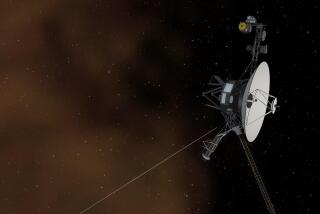Aging Craft’s Comet Fly-By a Surprising Success
An aging spacecraft so wounded that engineers said it was flying only on “duct tape and good wishes” defied odds over the weekend to complete a risky fly-by of the speeding comet Borrelly.
NASA’s Deep Space 1 craft took dozens of photographs that have stunned scientists at NASA’s Jet Propulsion Laboratory and made myriad chemical analyses that could help scientists understand exactly what comets are made of and how they formed.
“We had a good night,” JPL project scientist Robert M. Nelson said Sunday. “We’re calling it the little spacecraft that could.”
Comets--frozen masses of dust and gas--are a common presence in our solar system, yet are little understood. Scientists have been seeking to understand them better because they are thought to carry remnants of the material that made up the early solar system.
Cometary impacts may have been responsible for seeding Earth with the water and chemical building blocks needed for life. Comets crashing into Earth also may have caused some of the planet’s largest mass extinctions.
“Comets are a key gateway to understand our past, the conditions of our origins,” Nelson said.
Deep Space 1 was never designed to explore a comet. Indeed, it was not meant to conduct scientific missions at all, rather, to test a new spacecraft propulsion system and other futuristic space technologies. In 1999, the spacecraft was almost lost, but JPL engineers rescued it, and NASA decided to use it for this one last mission.
Flying at 36,900 mph, just 1,400 miles from the core of the comet, Deep Space 1 successfully oriented itself toward Borrelly, snapped a series of photographs and avoided the steady rain of cometary debris that might have crushed it.
Deep Space 1 had no shielding for such an assault. It was also running on empty; the craft had very little hydrazine, the fuel used to adjust position during navigation.
“Everything went absolutely perfectly, just according to plan. It was kind of eerie,” said Marc Rayman, the Deep Space 1 project manager who has been “nursing the wounded and aging bird” for several years.
“Our hopes were high,” he said Sunday. “But my expectations were low.”
The fly-by occurred late Saturday afternoon, 137 million miles from Earth. Engineers knew immediately that the spacecraft had survived the fly-by because its secondary, low-gain antenna continued to send signals.
But it was not until Saturday night, when the high-gain antenna began beaming the first black-and-white pictures of the comet back to Earth, that the JPL control room erupted into cheers. “We were on pins and needles until the first image flashed on the screen,” Nelson said.
“There were so many cheers,” said Rayman, “I thought we might actually pose a seismic risk to Southern California.”
One of the most notable aspects of the mission is that the craft was able to locate and remain fixed on its photographic target--the nucleus of the comet--on its own. “The engineers designed a craft that could guide itself during a fly-by,” said Nelson. “That’s an engineering breakthrough.”
The relatively low-cost--$162 million--Deep Space 1 mission was launched in October 1998 to test 12 futuristic space technologies, including a long-range ion propulsion system plucked from the pages of a science fiction novel.
(The ion propulsion engine uses a gas called xenon as fuel. The xenon atoms are ionized--given an electrical charge--and then accelerated to high speeds. When the atoms are emitted at high speeds in an eerie blue glow of exhaust, they push the craft forward. Although the stream of exhaust provides only gentle thrust, the constant push builds up over time to very high speed. The craft has reached speeds of 57,000 mph.)
The craft was already destined for the history books because it had done so well on its yearlong shakeout cruise. It had also gone beyond the call of duty in July 1999, when it flew past the asteroid Braille. Although the fly-by was successful, the photos taken during the mission were disappointing. The blurry images showed how tricky such maneuvers can be.
In November 1999, the spacecraft faltered. Its primary tracking system, a computerized camera that analyzes stars to determine the craft’s position, failed. Such losses are usually fatal to a spacecraft.
It would have been a paradoxical way for the mission to end. The exotic technologies aboard had all worked like a dream. But Star Tracker--a tried and true technology--was no-go. And Deep Space 1 was 200 million miles away.
Although many at NASA thought it best to retire the spacecraft, a small group of JPL engineers led by Rayman set about a long-distance rescue. They figured out a way to get the spacecraft to orient its antenna toward Earth without its guidance system so it could receive new instructions. Then, they beamed a steady stream of 90 new software files to the ailing craft.
The software told Deep Space 1 to use another experimental camera that was on board as a replacement guidance system. Doing that meant teaching the spacecraft to think differently. And the new camera had a tiny field of view, about the size of the full moon, compared with Star Tracker’s broad, Big Dipper-sized view.
Rayman, 44, is a 15-year JPL veteran and an avid space buff whose favorite motto has become “If it isn’t impossible, it isn’t worth doing.” Rescuing the craft, he said, was comparable to any number of “Star Trek” episodes in which Chief Engineer Scotty is given an alien technology to install but never has enough time to do so.
“That’s the way I felt,” said Rayman. “But to rescue a mortally wounded spacecraft across the solar system was an extraordinary opportunity.”
That rescue made the weekend’s comet encounter possible.
Pictures and data were still arriving from the spacecraft late Sunday and were already undergoing extensive scientific analysis. Other instruments aboard the spacecraft analyzed material surrounding the comet and the violent jets of dust and gas shooting from Borrelly’s nucleus. NASA plans to release the images Tuesday.
The stout-tailed Borrelly, while not one of the most dazzling comets in the night sky, is one of the most interesting to scientists. It is a Jupiter-class comet, which means it takes relatively short trips around the sun and remains highly active. Borrelly’s orbital period is less than seven years, compared with Comet Halley’s 76.
The images are not the first close-up images taken of a comet. An armada of five spacecraft from various countries attempted to photograph Halley in the mid-1980s. But many of the photos taken were blurry.
The new pictures appear to be much more distinct. Moreover, scientists say, it is important to photograph a variety of comets. “You can’t know everything there is to know about comets by studying one any more than you can learn about humanity by studying one person,” Rayman said. “They are as diverse as people.”
(BEGIN TEXT OF INFOBOX / INFOGRAPHIC)
Going the Extra Distance
The Deep Space 1 spacecraft, shown here in an artist’s rendering, was launched in 1998 to test a propulsion system that may one day be used for voyages outside the solar system. It has gone beyond the call of duty, investigating an asteroid and now, a comet, by photographing them.
*
The engine: The Deep Space 1 spacecraft is the first to use ion propulsion instead of chemical fuel to move. This picture of a prototype engine at JPL shows the faint glow of charged xenon atoms emitted from the engine.
*
The quest: Comet Borrelly, traveling through the constellation Gemini, looks like a big fuzzy blob with a stout tail. A comet is a mixture of ice, dust, rock and gases that vaporizes as it nears the sun.
*
Sources: NASA/JPL/Caltech, Tim Puckett/Science@NASA
LYNN MEERSMAN / Los Angeles Times






